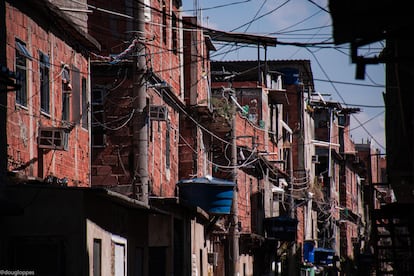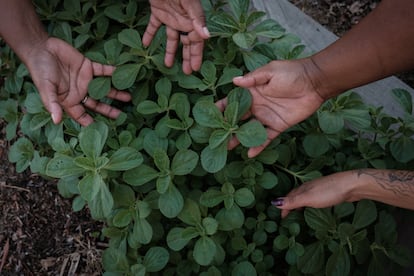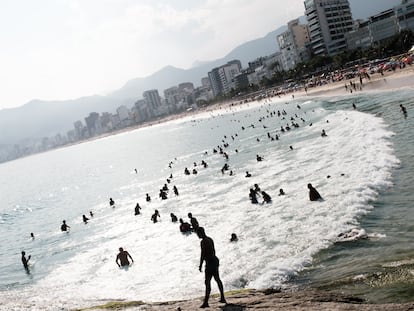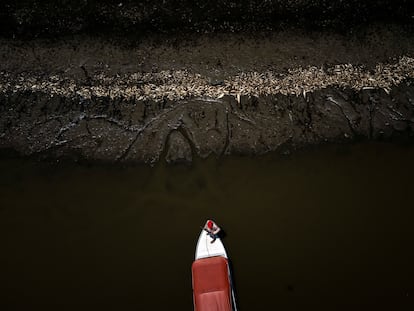Real feel of over 140ºF: Why it’s hotter in Rio’s favelas
Brazilian suburbs can experience temperatures up to 46°F higher than nearby neighborhoods. Climate change exacerbates inequalities and has a particularly strong impact on people of African descent

Soraia Claudino, a 58-year-old woman who sells homemade food, has lived in Rubens Vaz Park since she was two, when her home was still a house on stilts. Today, her favela, located in the northern part of Rio de Janeiro, has changed: the cement houses have tiled facades. Although modest, many have two or three floors, which blocks ventilation and makes the heat feel more intense, especially on days like those experienced this March, when heat records were broken in Rio.
In the middle of the month, Rio de Janeiro recorded 111.2ºF (44°C), the highest temperature in a decade, according to the Rio Alert System. In Complexo da Maré, the group of 15 favelas where Claudino lives, the heat was even more intense, with an apparent temperature (or real feel) of 140ºF (60°C), as recorded by the thermometer of Redes da Maré, a local community organization working for social inclusion and improving the quality of life in that neighborhood. “This excessive heat is not just a Rio summer, but a reflection of the climate crisis,” says Everton Pereira, a resident of the Complexo and coordinator of the organization’s urban and socio-environmental rights division.
For Claudino, an outgoing, resilient Black woman who walks the streets of her community selling homemade sandwiches and pastries in the summer and corn soup and caldo verde in the winter, the high temperatures mean a change in her routine. “On extremely hot days, I go out after 4 p.m. to sell, when the air is a little cooler,” she says.
In mid-March, she noticed the effects that the 140ºF temperature had on people’s health in her favela: “There were residents with a lot of allergies, people with high blood pressure, not to mention that we often feel like there’s no air circulation in the community,” she says.
This isn’t just a perception. According to the Municipal Health Department, more than 3,000 people required medical attention for dehydration, heatstroke, and other health problems due to the heat alert. The World Health Organization (WHO) recognizes that high temperatures can worsen cardiovascular, respiratory, and mental health conditions, and can even be fatal.

It’s no coincidence that favelas like the one Soraia lives in are hotter. The community is located between Rio’s three main highways, surrounded by asphalt and concrete, and exposed to more pollution and higher temperatures than neighboring areas, a climate phenomenon known as “heat islands.” In February, the Galeão neighborhood of Rio de Janeiro International Airport, next to the Complexo da Maré, was 7.2ºF (4ºC) cooler than the community, according to research that collected data on air quality and temperature in the favela.
Cases like this reflect a reality: the Afro-descendant population living in favelas and marginalized areas of Brazil, which traditionally suffers most from historical inequality, poverty, and the lack of public services such as basic sanitation, healthcare, and education, is also the one most-affected by the effects of environmental change.
Why is it hotter in the favela?
In the Complexo da Maré, 140,000 people live in an area of just over 1.5 square miles. More than 62% define themselves as Afro-descendant, according to the Maré Census. In addition to high population density, the structure of favela housing also contributes to heat retention, according to a 2022 study by the Oswaldo Cruz Foundation (Fiocruz). These buildings tend to have poor ventilation and materials such as zinc tiles and thin masonry walls without thermal insulation. “The lack of urban planning and socioeconomic inequalities make favelas more susceptible to the consequences of climate change,” acknowledges Everton Pereira.
In Brazil, approximately 8.1% of the population lives in favelas: more than 16 million people, according to the national census. Most residents identify as Afro-descendants (Black and mixed-race). Temperatures in these neighborhoods are up to 14.4ºF (8ºC) higher than those in neighboring areas, according to research conducted by Mackenzie Presbyterian University in Paraisópolis, the largest favela in São Paulo.

Affluent areas have more green areas and better urban planning. Furthermore, their residents tend to have more resources to purchase air conditioning and can afford higher electricity costs, reflecting thermal inequality, one aspect of what is known as environmental racism.
Geographer Gabriela Conc, co-founder of the NGO Voz das Comunidades and a leader in sustainability and social justice initiatives, explains that climate racism occurs when already disadvantaged communities, deprived of basic rights such as sanitation, infrastructure, and equitable access, are further affected by climate change and environmental disasters. “Environmental racism is not only an ecological issue, but also a social and racial one,” she emphasizes.
Favelas are also often more vulnerable to environmental disasters such as landslides and floods, events that can cause families to lose everything overnight, as well as to structural problems such as water outages. “This vulnerability is not a coincidence, but rather a reflection of a structure that prioritizes investments in privileged neighborhoods, leaving the periphery unprotected,” says climate activist Amanda Costa, who lives in Brasilândia, in the northern part of São Paulo, and has participated in five United Nations Climate Change Conferences (COP).
Costa founded the Perifa Sustentável (Sustainable Periphery) Institute, which trains young people to debate and demand solutions to the climate crisis. One of the organization’s projects, Climate Voices, pressured candidates in the 2024 municipal elections to make real commitments to favela communities.
“The climate crisis has color”
“Climate justice is recognizing that the climate crisis has color, class, gender, and territory,” says Naira Santa Rita, climate justice and Amazon coordinator at Oxfam Brazil and founder of the DuClima Institute. This 27-year-old woman became a climate displaced person three years ago when she had to leave her city, Petrópolis, in the state of Rio de Janeiro, due to devastating floods that left more than 150 people dead and more than 4,000 homeless.
Santa Rita lived in an area that, as it later emerged, had structural vulnerabilities that had historically gone unaddressed by authorities. “The tragedy revealed what the climate crisis means in real life: human losses, territorial ruptures, collective grief, and a lack of state responses,” she says.

For her, public urban development policies in Brazil don’t consider favelas because the state still views them as a “problem,” rather than as part of the city. “When the state doesn’t urbanize, it denies citizenship,” she points out. And this denial, she adds, is deeply racialized, as favelas are “territories of Black and peripheral resistance.”
This resilience also extends to the climate. Soraia Claudiano knows this well. On the roof of her house in the Complexo da Maré, she has a prototype green roof, a plant-based covering that helps reduce heat and pollution and filters the air. This system was installed by the community organization Redes da Maré through the EcoClima Project, in partnership with the state-owned petroleum company Petrobras. According to the organization, this system makes the temperature inside the house 10ºC lower than when it had a zinc roof. “It brings freshness,” she acknowledges. “If we had more trees in the community, it would help even more.”
The green roof brings relief, but its installation, which costs around 15,000 reais (more than $2,600) for a 25-square-meter roof, is unaffordable for most of the favela’s low-income residents. For someone earning the minimum wage, this would be equivalent to more than 10 months’ salary. Therefore, while the Redes da Maré project demonstrates that local initiatives can offer immediate solutions, true transformation depends on a broader commitment from public authorities.
For this reason, Naira Santa Rita advocates for the implementation of climate adaptation measures to reduce heat in favelas, such as increasing vegetation cover, using building materials that help reduce temperatures, providing access to drinking water and basic sanitation, and creating thermal breathing spaces such as plazas, gardens and urban vegetable plots.
“Climate adaptation is a collective right, not an individual privilege,” she argues. For her, the state has the responsibility to guarantee climate justice and assume the costs of repair, mitigation, and adaptation. “It must guarantee rights, equity, and dignity in a world in emergency, because the climate crisis is, above all, a human rights crisis.”
Sign up for our weekly newsletter to get more English-language news coverage from EL PAÍS USA Edition
Tu suscripción se está usando en otro dispositivo
¿Quieres añadir otro usuario a tu suscripción?
Si continúas leyendo en este dispositivo, no se podrá leer en el otro.
FlechaTu suscripción se está usando en otro dispositivo y solo puedes acceder a EL PAÍS desde un dispositivo a la vez.
Si quieres compartir tu cuenta, cambia tu suscripción a la modalidad Premium, así podrás añadir otro usuario. Cada uno accederá con su propia cuenta de email, lo que os permitirá personalizar vuestra experiencia en EL PAÍS.
¿Tienes una suscripción de empresa? Accede aquí para contratar más cuentas.
En el caso de no saber quién está usando tu cuenta, te recomendamos cambiar tu contraseña aquí.
Si decides continuar compartiendo tu cuenta, este mensaje se mostrará en tu dispositivo y en el de la otra persona que está usando tu cuenta de forma indefinida, afectando a tu experiencia de lectura. Puedes consultar aquí los términos y condiciones de la suscripción digital.
More information
Archived In
Últimas noticias
Christmas loses its festive spirit: ICE fears cast shadow over religious celebrations
All the effects of gentrification in one corner of Mexico’s Colonia Roma
Palestinian reporter Youmna El Sayed: ‘My family told me I had to choose between being a journalist or a mother’
Russell Tovey: ‘I was advised many times not to come out, I don’t think there was many people who’d done that — and I feel really proud that I’m one of those that did’
Most viewed
- Families demand repatriation of bodies of Colombians who died in Ukraine: ‘This war is a slaughterhouse for foreigners’
- The low-cost creative revolution: How technology is making art accessible to everyone
- Liset Menéndez de la Prida, neuroscientist: ‘It’s not normal to constantly seek pleasure; it’s important to be bored, to be calm’
- Christian Louboutin: ‘Young people don’t want to be like their parents. And if their parents wear sneakers, they’re going to look for something else’
- ‘El Limones’ and the growing union disguise of Mexican organized crime










































